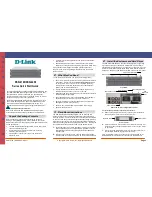
Serial ATA 4-Drive NAS
User Guide
Getting Started - 12
considerations, see
“Step One: Determine Your Configuration”
on page 12.
2. Set up your storage system.
This involves installing the hard disks, attaching any optional USB devices, attaching the storage sys-
tem to your network, and powering up the system.
For information about this step, see
“Step Two: Set up Your storage system”
on page 13.
3. Install the Storage System Console.
You will need the Storage System Console to initialize your hard disks in step 4.
For information about this step, see
“Step Three: Install the Storage System Console”
on page 16
4. Initialize the Hard Disks.
This step loads firmware from the storage unit’s memory to each disk.
“Step Four: Initialize the Hard
Disks”
on page 17.
5. Configure your storage system.
Before you can use your storage system, you need to perform some initial configuration tasks, like set-
ting the date and time, and specifying how much space to use for file sharing and how much to use for
backups. The System Setup wizard guides you through this process.
For information about this step, see
“Step Five: Configure your Storage System”
on page 20.
If you bought your Serial ATA 4-Drive NAS with the disks already installed and configured, and you do not
want to change your disk configuration, skip step one and proceed with
“Attaching USB Devices”
in step
two on page 15.
Step One: Determine Your Configuration
Before you start the physical installation of your storage system, decide which configuration is best suited
to your needs. The configuration that you choose may affect the order in which you load the disks into your
storage system, and you will need to specify your configuration choice when you reach
“Step Five:
Configure your Storage System”
on page 20.
Each supported configuration has a different balance of desirable characteristics, as shown in the table
below. The configurations available to you depend on the number of disks installed in your storage system.
Use this table to select your configuration based on the number of disks you intend to use and the
characteristics that are of the highest priority to you.
Number
of Disks Configuration Methods Used
Configuration Characteristics
Available
Capacity*
Data
Redundancy Performance
1
Linear
Independent disks
500 GB
No
Good
2
Linear
Independent disks
1.0 TB
No
Good
RAID 0
Striping
1.0 TB
No
High
RAID 1
Mirroring
500 GB
Yes
Good
Summary of Contents for USR8700
Page 1: ...Serial ATA 4 Drive NAS User Guide R46 1702 00 rev 0 8 04 07 ...
Page 6: ...Serial ATA 4 Drive NAS User Guide vi ...
Page 8: ...Serial ATA 4 Drive NAS User Guide Safety Instructions 8 ...
Page 46: ...Serial ATA 4 Drive NAS User Guide Getting Started 44 ...
Page 86: ...Serial ATA 4 Drive NAS User Guide Managing Your Storage System 84 ...
Page 126: ...Serial ATA 4 Drive NAS User Guide Protecting Local Disks 124 ...
Page 136: ...Serial ATA 4 Drive NAS User Guide Disk Configurations 134 ...















































